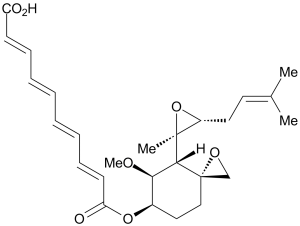This product is for research use only, not for human use. We do not sell to patients.

| Size | Price | Stock |
|---|---|---|
| 100mg | $2050 | Check With Us |
| 200mg | $3075 | Check With Us |
| 500mg | $5150 | Check With Us |
Cat #: V1870 CAS #: 23110-15-8 Purity ≥ 98%
Description: Fumagillin (formerly known as NSC9168) is a novel, potent, selective and irreversible/covalent inhibitor of Methionine aminopeptidase 2 (MetAP2), it is primarily used as an antibiotic / antimicrobial to treat microsporidiosis. Fumagillin is a complex natural product antibiotic isolated in 1949 from the microbial organism Aspergillus fumigatus. It covalently binds a key histidine residue of methionine aminopeptidase type II (MetAP-2), inhibiting endothelial cell proliferation and angiogenesis. Fumagillin selectively inhibits the growth of a Δmap1 strain but not a wild-type or a Δmap2 S. cerevisiae strain missing MetAP-2.
Publications Citing InvivoChem Products
Product Promise

- Physicochemical and Storage Information
- Protocol
- Related Biological Data
- Stock Solution Preparation
- Quality Control Documentation
| Molecular Weight (MW) | 458.54 |
|---|---|
| Molecular Formula | C26H34O7 |
| CAS No. | 23110-15-8 |
| Storage | -20℃ for 3 years in powder formr |
| -80℃ for 2 years in solvent | |
| Solubility In Vitro | DMSO: 92 mg/mL (200.6 mM)r |
| Water: <1 mg/mLr | |
| Ethanol: 32 mg/mL (69.8 mM) | |
| SMILES Code | O=C(O)/C=C/C=C/C=C/C=C/C(O[C@H](CC1)[C@@H](OC)[C@H]([C@@]2(C)OC2C/C=C(C)\C)[C@]31CO3)=O |
| Synonyms | NSC9168; NSC 9168; NSC-9168; Fumidil B; trade names: Fumagilina; Fugillin; Fumidil. |
| Protocol | In Vitro | In vitro activity: Fumagillin selectively inhibits the growth of a Δmap1 strain but not a wild-type or a Δmap2 S. cerevisiae strain missing MetAP-2. In budding yeast cells, as a potent inhibitor of angiogenesis, Fumagillin not only reverses the growth inhibitory activity of Vpr, but also inhibits Vpr-dependent viral gene expression upon the infection of human macrophages. Though the toxicity of fumagillin has limited its use for human applications, the analogues using structure-activity relationships relating to its angiogenesis properties may be further explored in the treatment of angiogenesis-dependent diseases. |
|---|---|---|
| In Vivo | In DEN-treated rats, fumagillin (30 mg/kg, i.p.) inhibits both progression of HCC in the liver itself and systemic metastasis. | |
| Animal model | Rats | |
| Dosages | 30 mg/kg, i.p. |
| Solvent volume to be added | Mass (the weight of a compound) | |||
|---|---|---|---|---|
| Mother liquor concentration | 1mg | 5mg | 10mg | 20mg |
| 1mM | 2.1808 mL | 10.9042 mL | 21.8083 mL | 43.6167 mL |
| 5mM | 0.4362 mL | 2.1808 mL | 4.3617 mL | 8.7233 mL |
| 10mM | 0.2181 mL | 1.0904 mL | 2.1808 mL | 4.3617 mL |
| 20mM | 0.1090 mL | 0.5452 mL | 1.0904 mL | 2.1808 mL |
This equation is commonly abbreviated as: C1 V1 = C2 V2
- (1) Please be sure that the solution is clear before the addition of next solvent. Dissolution methods like vortex, ultrasound or warming and heat may be used to aid dissolving.
- (2) Be sure to add the solvent(s) in order.




































